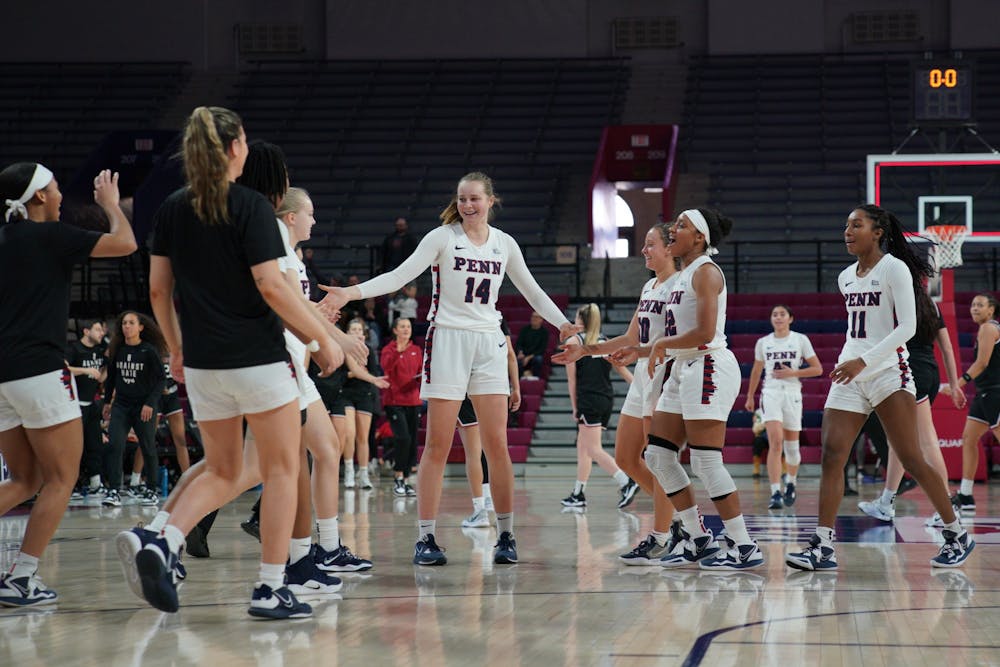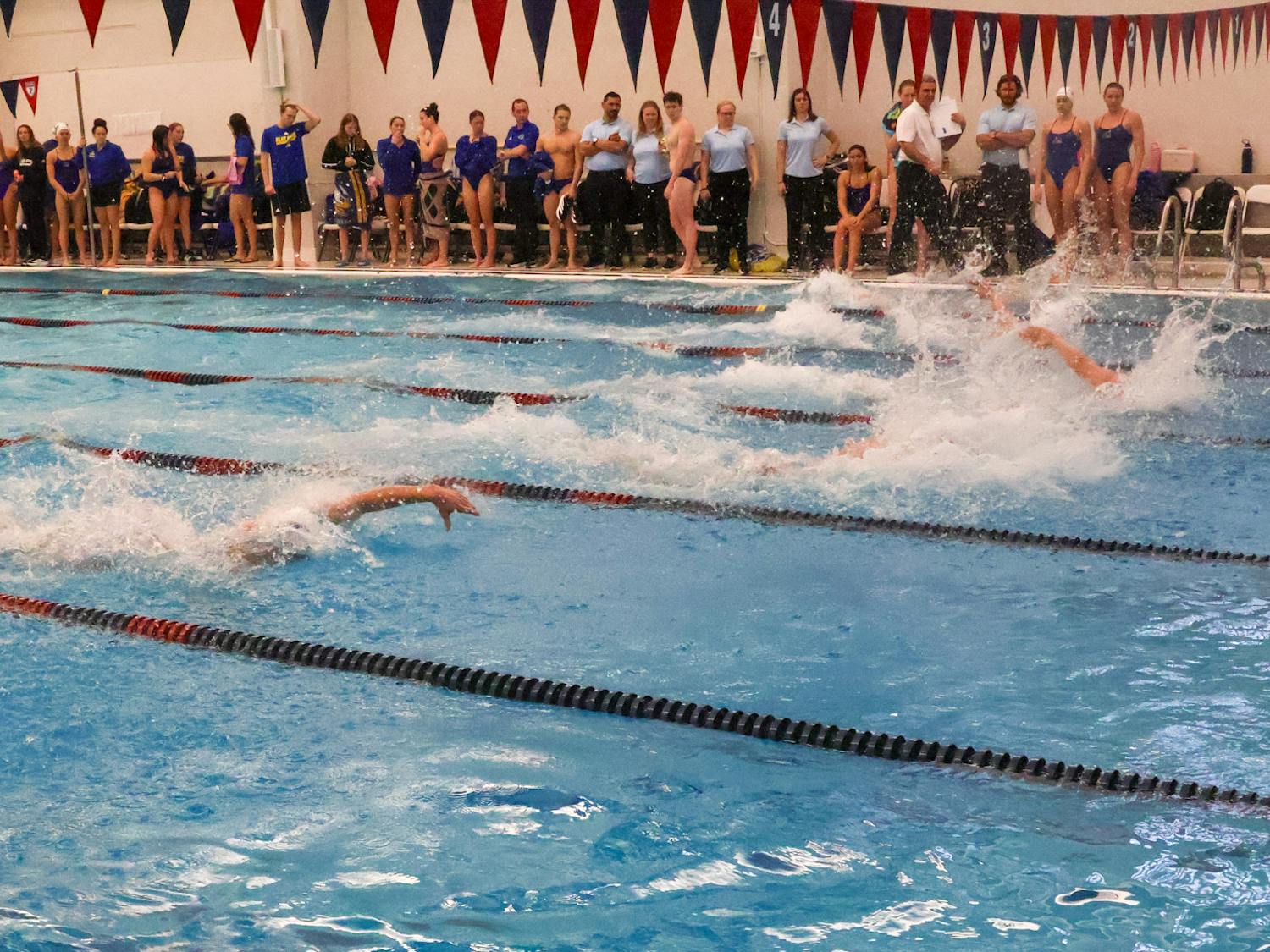Following the conclusion of the men's and women's basketball season, The Daily Pennsylvanian analyzed data for both Penn teams to find out what made this season stand out. Additionally, the DP looked at which statistics were most different in wins and losses to attempt to deduce both teams' keys to victory. To conduct this analysis, the DP used season-long and game-by-game data from Penn Athletics for the 2022-23 Penn basketball seasons.
Men’s
This season, the Quakers improved from last year’s 12-16 to finish 17-13 overall and 9-5 in conference. But like 2021-22, Penn fell in the semifinals of the Ivy League Tournament, with a 77-70 loss to Princeton.
Junior guard Jordan Dingle — the second-leading scorer in all of Division I — served as the team’s primary offensive weapon alongside junior guard Clark Slajchert, junior forward/guard Max Martz, and sophomore forward/center Nick Spinoso.
The Quakers lost their first three games, before winning four in a row and losing three consecutive Big 5 matches — all before conference play began. Against Ivy opponents, the Quakers started 2-4 before a seven-game winning streak. However, Penn lost its final two games of the season, including its regular season finale against Princeton and again to the Tigers during Ivy Madness.
Shooting swoons, and slumps
Although shooting can vary from game to game, how the team performed from long range played a crucial role. Even though coach Steve Donahue said that this was not “a team that relied on the three pointer as much as our teams in the past,” the game-by-game statistics sheds doubt on this statement.
In victories, the Quakers made over 40% of their threes, which would rank first even among NBA teams this season. However, in losses, Penn struggled to connect beyond the arc.
This did not mean that making a lot of threes guaranteed a win, though. Against Missouri, Penn connected on 16 of 32 long-range attempts yet lost 92-85. But Penn losses have often corresponded with subpar performances from deep, including against Princeton on Jan. 16 (0-12), Iona (3-25), and Cornell on Jan. 6 (4-19).
Headed into next season, Donahue emphasized the need for higher-quality looks from deep, saying “I want [the team] to take more catch-and-shoot threes.”
In wins, Penn had elite shooting from beyond the arc, but in losses the Quakers were subpar
(Safe) ball movement is key
Another key to success for the men's squad involved limiting turnovers, while generating open shots and assists. The Quakers had more assists (16.1 vs. 13.1) and fewer turnovers (12.1 vs. 13.5) on a per-game basis in victories then compared to in losses.
Overall, these statistics are important to Donahue, who said that he’d “love to have three less turnovers a game.”
The assist numbers at the extremes also help tell this story. The Quakers won five of six games with at least 20 assists, and lost two of three with under 10. This category is where Penn may be losing strong pieces headed into the next season as Dingle could be headed to the NBA draft, and senior forward Lucas Monroe is set to graduate. Both players finished top three in assists.
But Donahue's confidence in Spinoso is strong, and believes he can help fill the void. Spinoso led Penn in assists and was recently named Big 5 Most Improved Player, and Donahue thinks that “he can be the most improved player [again] next year because I think there’s that much growth involved in his game.”
Penn men's basketball had more assists and turned the ball over less in wins compared to losses
Getting back in transition
But where turnovers really came to haunt the Quakers is when their opponents could convert them into points, especially in transition. Penn gave up 11.5 fast break points per game in losses, compared to just 6.4 in wins.
The game-by-game numbers are also clear. The Quakers were 8-1 when allowing four or fewer fast break points, and 2-3 in the five games where their opponents scored the most in transition. Yet, Donahue declined to blame transition defense specifically, instead choosing to focus on defense as a whole.
“I think if we’re going to take another big step, defense [will have to] take a big jump,” he said. “I think us guarding individually on the ball has to get better, we keep people in front.”
Getting back and transition to prevent quick baskets from opponents were key for Penn
Women’s
Penn women’s basketball improved from last season’s 12-14 final record, finishing the 2022-23 season 17-12 — including a 9-5 conference record. The team also clinched its first Ivy Madness berth in three years, but lost in the tournament’s semifinals to Princeton before ending its season in the first round of the WNIT with a loss at Richmond.
Much of what Penn did this season relied on Kayla Padilla. The senior guard led the team in minutes, scoring, and assists, while setting the single-season and career records for made three pointers. She was joined by junior forwards Jordan Obi and Floor Toonders, senior guard Mandy McGurk, and freshman guard Simone Sawyer as the team’s regular starters.
Just like the men, the women’s team was streaky throughout the season. After starting the year 1-5, the Quakers won 11 straight, including their first four conference games. But after a Martin Luther King, Jr. Day loss at Princeton, they finished the year 5-6, including the postseason.
The importance of shotmaking
A lot of how the Red and Blue performed depended on shooting performance. But, unlike the men’s team, the gap is bigger in terms of overall field goal percentage — not just from long range.
Overall, Penn made a hair over 40% of its field goals. In wins, though, this number jumps to 45.4% — better than conference-leading Harvard. But in losses, this stat is only 33.3%, which would have come in below Dartmouth, a team that failed to win a single conference game.
The game-by-game numbers put this contrast in even starker terms. When Penn made under 35% of its field goals, the team was 1-8. But when they made over 40%, the Quakers went 13-1.
Headed into next season, coach Mike McLaughlin acknowledged that the Quakers will need to make adjustments if it wants to maintain, or even improve, their shooting. Padilla and McGurk are both graduating, and the two finished top-three in scoring, minutes, and field-goal attempts.
“[McGurk] really developed as a player each year … and the culmination of her career [was] an outstanding senior year, and Kayla’s ability to make … will be greatly missed,” McLaughlin said. “We are going to have to rely on some of the players that are returning that haven’t got a whole lot of opportunities.”
In wins, Penn shot like an elite team. In losses, it was the worst in the Ivy League
Getting the (quick and easy) buckets
Another key differentiating factor is how much Penn could score off turnovers and in transition. When the Red and Blue won, it averaged over 16 points off turnovers per game, but when they lost, the team only barely managed half of that.
Much of this had to do with the impact of McGurk, who led the team in steals with 49. McLaughlin praised her ability to force turnovers and quickly score on the other end. But he also acknowledged that as the team is built more around Obi — who finished second with 27 — next season, these easy baskets are going to be key.
The Quakers scored nearly twice as many points off turnovers in wins compared to in losses
Simone Sawyer soars
From her first game with significant court time, Sawyer excelled in the Red and Blue. She started seeing large minutes on a West Coast trip in November, and she scored 36 points across the two games — against San Francisco and USC. Sawyer was integral to Penn’s 11-game win streak, averaging nearly 25 minutes and 10 points per game in that span.
McLaughlin applauded her impact on the team this year, and the numbers back it up. Sawyer averaged 23 minutes and nine points per game in wins, and just 15 minutes and four points in losses.
“Simone had a very good year, [but] I think you’ll see some immediate growth from her next season," he said. "As someone who can spread the floor and who’s a plus athlete, she runs the floor hard, she competes, and I could see her game continue to advance.”
Freshman Simone Sawyer's impact was nearly immediate and huge for Penn
Senior reporter Kira Wang contributed to this story.








